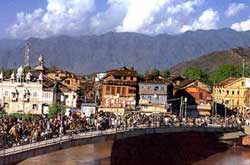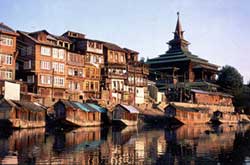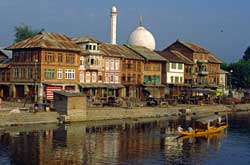With its almost medieval charm, the old city of Srinagar has sights, smells and sounds to enchant the most jaded traveller. Its labyrinthine roads and bustling bazaars are a photographer's delight. Traditionally dressed men and women on their way to the city's many mosques and shrines, burnt brick buildings with their rich warm colour, these are some of the old city's moods which linger in the corners of a traveller's mind, long after one leaves Kashmir.
| |
 |
Lending the area its vitality is the presence of the river Jhelum that flows through it. Srinagar has for long been Kashmir's most important commercial town, and when one considers that boats have always been a primary means of conveyance in Kashmir, it is not difficult to see why. In time, the city has formed around the banks of the river. Today, the presence of the river Jhelum has become an integral part of the old city, despite the fact that boats are no longer so extensively used as a means of conveyance. Nine bridges span the River Jhelum, and many, many more tiny ones intersect the network of waterways that flow through the old city.
The nine bridges are Zero Bridge, Amira Kadal, Budshah Kadal, Habba Kadal, Fateh Kadal, Zaina Kadal, Aali Kadal, Nawa Kadal and Safa Kadal, ‘Kadal’ being the Kashmiri word for bridge. Of these Budshah Bridge and Zero Bridge are the newest; the former having been constructed by the British in this century. Presently, the oldest bridge is Fateh Kadal, too dilapidated for actual use. However, many of the old bridges have been replaced with new concrete bridges and a few new ones have also been added in view of the increasing traffic. The most prominent among these is the Abdullah Bridge, situated near the Tourist Reception Centre.
The view from any of the old city's bridges is wholly and unmistakably Kashmiri. Old brick buildings line the banks. The distinctive pagoda-like roof of a mosque or a shrine enlivens the horizon, and in the muddy water of the River Jhelum, a straggling row of doongas flanks the edges. These boats, with their shingled roofs, are the forerunners of Srinagar’s houseboat. A particular community lives in them. Formerly this community was associated with ferrying people, livestock and food grains along the river. The past still lingers in their lifestyles even if their occupations have changed. Occasionally one may catch sight of a doonga making its stately progress down the river as the owner shifts residence! Doongas are sparsely furnished - virtually no furniture is seen except for the kitchen, which gleams with copper utensils of every description that line the shelves from floor to ceiling.
 |
|
Roads in the old city tend to be narrow, winding and chaotic. Some are too narrow to admit vehicular traffic. Each road connects to lanes and they in turn to bye-lanes, all appearing to the uninitiated and terribly confusing. There are arterial roads, however, and major market squares where it is difficult to get lost.
In a lane off Nowhatta Chowk, there are several copper shops, overflowing with an amazing profusion of copperware. As a matter of fact, such shops are situated all over the old city because every Kashmiri uses copper for tableware - even huqqa bases are made from copper. Some articles are un-patterned, others worked in bas-relief, engraving or pierced open-work. Exotic as they are, they make attractive ornaments about the house, or can be used as serving dishes.
One of the many moods of the old city is the constant reminder about its tradition of handicrafts. Well-appointed shops in the fashionable areas of Srinagar seem rather remote from the humble families of craftsmen who create tapestries and shawls; the old city changes all that. From top floor windows one catches sight of gaily embroidered fabric hanging out to dry. Occasionally a wizened old man cycles down the road, bearing a carpet, its lustrous colours glowing in the sunlight.
Kashmiri colours are not the fiery colours of the desert that sear the eyelids. They are subdued, almost purposely it would seem, to counterpoint nature's magnificence. Earthy tones of brick, the rich hue of copper, even the vermilion of Kashmiri chillies drying on window sills in autumn appear monochromatic when set off against the splendour of the Valley’s backdrop. The only craft where Kashmiris revel in colour is in their carpets. Here too, the colours are never loud, never disharmonious, but always subtle and soft. At Habba Kadal, shop after shop sells nothing but skeins of wool, mainly to carpet weavers. Study the muted tones and then relate them to the carpets that you see - as long as the colours remain in your mind's eye, you will never mistake a Kashmiri carpet.
| |
 |
The old city also boasts of Kashmir’s many ancient shrines and mosques among which the shrine of Shah-i-Hamdan, situated between Habba Kadal and Fateh Kadal, is probably the most important. Shah-i-Hamdan, who came from Persia in the 13th century, was responsible for the spread of Islam in Kashmir. Khanqah-i-Mualla, on the banks of the Jhelum, was the very spot where Shah-i-Hamdan used to offer prayers. Upon his death, a shrine, ornately decorated with papier-mache on the walls and ceiling, was built in his memory. Makhdoom Sahib, Patthar Masjid, Jama Masjid and Pir Dastagir are the major mosques and shrines in the old city.
Tourists are welcome to visit the mosques and shrines in the old city. There are a few points to be kept in mind in accordance with the sanctity of these places. Women are not allowed into the inner sanctum of shrines, but there is no such restriction in the case of mosques. Shoes must be taken off at the entrance. Jamia Masjid charges a fee for photography. Visitors are expected to conform to certain regulations in the matter of dress - no skimpy tops, shorts or short skirts are allowed.
One does not go to the old city to shop. The exhilaration in exploring the old city comes from peeping into a world which normally admits no outsiders and which continues at its own pace, not much affected by changing times. |